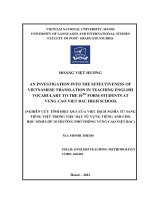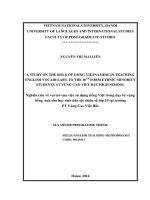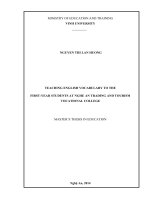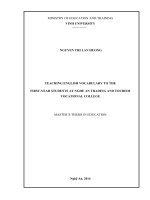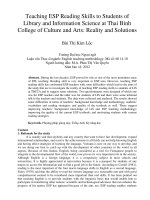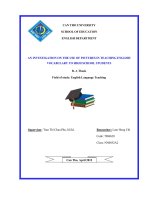Teaching english vocabulary to students of classes 12c10, 12c11, 12c12 at ham rong high school
Bạn đang xem bản rút gọn của tài liệu. Xem và tải ngay bản đầy đủ của tài liệu tại đây (243.17 KB, 21 trang )
THANH HOA DEPARTMENT OF EDUCATION AND TRAINING
HAM RONG HIGH SCHOOL
INITIATIVE EXPERIENCE
TEACHING ENGLISH VOCABULARY TO STUDENTS
OF CLASSES 12C10, 12C11, 12C12
AT HAM RONG HIGH SCHOOL
Researcher: Bui Thi Hieu
Function: Teacher
Work place: Ham Rong High School
Research field: English
1
THANH HOA 2020
2
TABLE OF CONTENTS
Contents
1. Introduction
1.1.Reason for choosing the topic
1.2. The scope of the study
1.3. Objectives of the study
1.4. Method of the study
1.5. Design of the study
2. Development
2.1. The basis of reasoning
2.2. A factual base English
2.3. The implementation process
I.
Showing the meaning of words visually
1. Using pictures and cards
2. Using media
3. Using real objects
II.
Words meanings from context
III. Using synonyms or antonyms
IV. Definitions and translations
1. Definition
2. Translation
V.
Exercises
1. Gap-filling exercise
2. Multiple-choice exercise
3. Finding
4. Conclusion and Proposals
4.1. Conclusion
4.2. Proposals
Page
1
1
1
1
2
2
2
2
3
3
3
3
6
7
8
8
9
9
10
11
11
13
15
16
16
17
1. INTRODUCTION
1.1.
Reason for choosing the topic
Foreign language teaching at high school level in Vietnam has been
granted increasing supports from educational authorities, regarding the demand
of Vietnamese young population for better means of communication with the
world.
Studies have shown that vocabulary knowledge is strongly correlated, and
researchers have found that word knowledge in high school can predict how
well students will be able to comprehend texts they read in high schools.
Limited vocabularies prevent students from comprehending a text.
Good
3
readers often acquire much of their vocabulary through wide independent
reading, also known as incidental learning. However, explicit instructions can
help students learn enough words to become better readers (and thus acquire
even more words). Direct vocabulary instructions are useful for students at all
ability levels, but it is particularly useful for beginning students who have a
limited reading vocabulary, little exposure to incidental vocabulary learning
outside of schools. Studies have shown that the key to increase vocabulary is
exposure to new words-not an innate ability to learn from context. Experts
emphasize that vocabulary development is an attainable goal. If given the
opportunity to learn new words as well as effective instruction, most students
can acquire vocabulary at rate that will improve their comprehension. This
enables them to read increasingly challenging texts with fluency and betters
their chances for success in school and afterward.
For all the reasons mentioned above, I would like to devote my time and
efforts to investigating some possible ways of choosing and using possible
methods in teaching vocabulary for students of three classes 12C10, 12C11,
12C12 at Ham Rong High School.
1.2.
The scope of the study
The study focuses on investigating some possible ways of choosing and using
methods in teaching vocabulary for students of three classes 12C10, 12C11,
12C12 at Ham Rong High School.
1.3.
Objectives of the study
The objectives of the study are as followed:
- To investigate the difficulties of teaching and learning vocabulary faced by the
students, the teachers’ solutions to these difficulties, and the students’
expectation by using teaching methods.
- To suggest some realistic and appropriate class techniques and communicative
activities with a view to helping teachers enhance their learners in Reading,
Speaking, Listening and Writing skills.
1.4.
Method of the study
Questionnaires are delivered to 100 students to find out the students attitudes to
speaking learning, difficulties confronted and solutions suggested by them. Then
4
interviews are carried out to increase the reliability of the obtained information.
1.5.
Design of the study
The topic consists of three parts:
Part 1 is the introduction, which presents the rational, the scope, the objectives,
the method, and the design of the study.
Part 2 consists of The basis reasoning, A factual base English, The
implementation process.
Part 3 consists of some sub-parts:
Finding, Conclusion and Proposals,
Suggesting activities by using possible teaching methods for students of three
classes 12C10, 12C11, 12C12 at Ham Rong High School.
2. DEVELOPMENT
2.1. The basis of reasoning
English is the most common language in the world, and it is one of the score
subjects in schools. Seeing the importance of it in international communication
as well as in the development of the international integration of Vietnam,
educational sector should select English as the most dominant subject. English is
not only the need for tourism, business, arts, information technology but it also
required in General Certificate of Secondary Education exam. So every student
while still sitting on the couch home high schools need to have certain level of
English to prepare for the exams and after graduating at least must be able to
communicate in simple daily levels. To do this we do not stop innovating
teaching methods to achieve high results for English and other subjects in
general. This is the contribution to success in the profession of “planting” of the
country.
2.2. A factual base English
Textbooks began to innovate along with other subject from 2006. The contents
of the lessons are long and hard, more diverse and sometimes abundant. It is
both difficult as well as advantageous for teachers in the teaching process. With
such changes, I understand that teaching English is to teach how to
communicate effectively rather than merely supplement the knowledge to
students. So, in addition to strong knowledge, teachers need to create lively
classes, attracting the attention of the students to help them confidently in the
5
process of learning and speaking English.
2.3. The implementation process
Over a number of years of teaching, my colleagues and I have found that with
new textbook, we should have the choice to fit teaching supplies effectively.
These are some methods I have applied to teach in school, which depend on
each lesson and time. In my initiative experience, I focus on four main methods
with exercises in the form of Gap - filling and Multiple- choice.
I. SHOWING THE MEANING OF WORDS VISUALLY
1. USING PICTURES AND CARDS
Picture cues are a great mechanism for teaching young students to study
vocabularies. They can combination of words and visual cues can help a young
mind piece together a word. There are several ways to approach it. The approach
shown here works with whole words. First, you can plan your lesson and pick
the words you'll teach your students. An effective way to do this is by categories.
Second, get the corresponding picture cue cards. You can obtain picture cue
cards with one letter on them or with entire words on them. When teaching a
student to read by showing whole words, it’s best to look for picture cue cards
that deal with life activities. These packages normally have food groups and
other categories in them. Third, sit the child down in a quiet place before starting
the lesson. The trick to getting picture cues to work is to keep a young student’s
attention and have her connect a picture with a word. This won’t happen if she
can’t see the picture cue card or is distracted by sounds. Fourth, pick up a picture
cue card and say the corresponding word. Make sure you explain what you are
doing before the lesson. Then, as you say the word and show the picture cue
card, allow a time delay. This time delay (1 to 3 seconds) will allow your student
to soak in the word and associate it with the image. After you show the picture
card, spell the word so your student will associate certain alphabetic letters with
the image. Next, repeat this exercise at least two times. This means you should
show a picture cue card of an apple and say the word twice. Repetition is a
proven method of learning, so use it to your advantage. Then, coordinate picture
cues with spelling lessons. You can do this by covering up the word on the
picture cue card and revealing only one letter at a time as the student says it to
6
you. This will further associate the word with the picture and help the young
student learn to read. Last but not least, allow your student a chance to show off
his stuff.
These are some activities which help students guess the meaning of vocabulary
which is related to the lesson.
ILLUSTRATED LECTURE
Unit 9: Deserts- Speaking (page 99)
Choose the right words or phrases, which best describeEucalyptus
the pictures.
CARDS:
A
desert
Eucalyptus
desert
B
C
Dessert
Date palm
D
E
Date palm
G
F
Frog
H
I
Grass
Dessert
Crocodile
Frog
Camel
Fox
J
PICTURES:
P1.
Grass
P2.
P3.
Lizard Crocodile
Lizard
P4.
P5.
7
P6.
P7.
P8.
P9.
P10
Students’ activities:
Students are divided two groups, and they have to observe pictures carefully and
use cards to paste in the pictures.
The class will be vibrant.
Teacher’s activities:
Teacher divides the class into 2 groups.
Teacher asks students to paste pictures, which are suitable with cards.
Teacher helps students to discuss.
Teacher gives small presents or adds mark for the winning group.
Teacher helps to read.
2. USING MEDIA
Almost any video can be used to teach English: commercial films, TV
programmers, home-made dramas and holiday films.
Live television
programmers are NOT recommended. Your method should vary according to
the language point you wish to teach and the level of your student(s). Although a
handset is ideal, it is not essential. Position yourself near the front of the class, to
one side - close enough to the video player to work the controls if you do not
have a handset. If the video player is independent of the TV, turn it so you can
work the controls easily without interfering with your students' view of the TV
screen. This medium can be used to practice consolidate range of language
points to introduce subject(s) for debate to encourage conversation amongst
8
students to improve writing skills to introduce new vocabulary to develop
listening skills (with visual aid) Few lessons would involve continuous viewing
- even with speech-free films. Strategic stopping is essential. The teacher
controls what students see and hear: Films, with excessive bad language, can be
shown without sound If the majority of film is good, unsuitable sex or violent
scenes can easily be avoided as follows plan in advance how to exploit the
remainder of the film knowing the exact counter positions of scenes to be
omitted.
ILLUSTRATED LECTURE
Unit 2: Cultural diversity - Listening (page 24)
Warm up:
Teacher gives a short video about a marriage in Vietnam and America.
When students watch video clip, T points some important words, which are
shown on screen.
Some important words:
Altar/ Master of ceremony/ Banquet/ Groom/ Bridge/ Ancestor/Tray/ Schedule/
Blessing
3. USING REAL OBJECTS
The main advantage of using real objects into the classroom is to make the
learning experience more memorable for the learner. To give a couple of simple
examples, if you are going to teach vocabulary of fruit and vegetables it can be
much more affective for students if they can touch, smell and see the objects at
the same time as hearing the new word. This would appeal to a wider range of
learner styles than a simple flashcard picture of the piece of fruit or vegetable.
(With very young learners, classroom management can become trickier if you
bring in real objects as excitement levels tend to rise. Last year one of my
students bit into an onion we were passing round. I’m sure he hasn’t forgotten
that class!)
A second example would be if you are going to teach some functional language
for asking for the timetable for a train. You could use a fictitious timetable or
you could use a real one from the local train station, one from the internet, or if
you’re really organized, some you brought back from your last trip to the UK.
9
This way you expose students to more language than simply the times and
destinations. They will see information about prices, discounts, bank holidays
etc.
ILLUSTRATED LECTURE
Unit 2: Cultural diversity – Writing (page 25)
Teacher brings the “Nónlá” (conical leaf hat)
Teacher shows it in front of the class
Teacher asks students to guess which is “leaf, rim, ribs, shape”
Students learn vocabularies by watching real objects
4. USING MINE
This is the way of using actions and facial expressions to show the meaning of
words. Most action verb (sits, stand, open…) and some adjectives showing
feelings and status (happy, worried…) can be taught using mine.
ILLUSTRATED LECTURE
Unit 3: Ways of socializing-Reading (page 30)
Warm up: Vocabularies
Some words teacher can express by actions:
Clap: Teacher claps in front of the class and asks students what it means
“Vỗtay”
Shake hand: Teacher shakes hands with one student in the class and asks
students what is he/ she doing “Bắttay”
Wave: Teacher also “waves” and makes students understand his/her actions.
II. WORD MEANINGS FROM CONTEXT
Using examples, situations, or explanations is another ways of showing what
word mean. Most abstract words (love, happiness…) can be taught effectively in
context. There are some points to consider when using this method. Besides, it is
not necessary to give a complicated explanation, the meaning can be shown by
simple sentences. The teacher can ask students to find the meaning by guessing
the meaning of sentences, which are around
ILLUSTRATED LECTURE
Unit 1: Home life - Reading (page 12)
Teacher asks students to see in the book and pay attention to the sentences.
10
“The main responsibility is to wash the dishes and take out the garbage”.
“I also look after the boys”.
Depending on the sentences teacher asks students to guess the meaning of words
“responsibility”, “look after”.
III. USING SYNONYMS OR ANTONYMS
Synonyms are different words with similar or identical meanings. They are
interchangeable.
For example: car and automobile.
Antonyms are words with opposite or nearly opposite meanings.
For example: large and small.
This is a nice warm up game using synonyms and antonyms. You can make it as
difficult or easy as you wish, depending on the level of your students. Hand out
a list of words to each student. There should be two columns next to each word,
label the heading of each column, synonym and antonym. You can make up your
own lists using words you've already taught. Thesaurus.com is a useful tool for
this exercise. Then read out the synonyms and antonyms of those words. The
students have to write these words next to the word they are the same or the
opposite of.
ILLUSTRATED LECTURE
Unit 6: Future Job - Speaking: Task 2 (page 66)
Find each pair ofantonym from the following:
boring
rewarding
dangerous
difficult
fantastic
easy
fascinating
unsatisfied
grotesque
safe
Teacher adds words in the board or give small handouts to ask students to match
Students guess and match.
Teacher checks corrected answers.
Teacher helps students to read vocabulary and explains.
IV. DEFINITIONS AND TRANSLATIONS
Applied linguists have for some time suggested that communicativecompetence
includes a major component, usually termed strategiccompetence, the
development
of
which
largely
determines
thelearner's
fluency
and
11
conversational skills. Practicing teachers,however, are usually unaware of the
significance of this competence,and hardly any activities have been developed to
include strategytraining in actual language teaching. The aim of this articleis to
bridge the gap between theory and practice by first describingstrategic
competence and then presenting language exercisesto facilitate its development.
1. DEFINITION
ILLUSTRATED LECTURE
Unit 10: Endangered species - Reading (page 107)
Task: The nouns in column A all appear in the passage. Match each of them
with a suitable definition in column B
A
extinction
B
a. The existence of a larger number of different kinds of
habitat
animal and plants which make a balanced environment
b. The act of preventing something from being lost,
biodiversity
wasted, damaged or destroyed
c. a situation in which a plant, an animal, a way of life
conservation
stops existing
d. The natural environment in which a plant or animal lives
Teacher asks students to work in groups
Students guess and match the word, which is suitable with its definition
Teacher suggests students find words in the text and guess the meaning
Teacher checks the answer.
2. TRANSLATION:
ILLUSTRATED LECTURE
Unit 9: Deserts- Reading task 1 (page 98)
Task 1: Give the Vietnamese equivalents to the following words or phrases
English
1. stretch
2. sandy
3. aerial survey
4. Royal Geography society of
Vietnamese
kéodài
thổdânÚc
HộiHoàngGia địalýÚc
cồncát
Australia
12
5. Australia Aborigine
6. dune
7. sloping
8. steep
9. hummock
10.crest
11. spinifex
Teacher asks students to work in groups
đỉnh
cócát
dốcthoaithoải
lánhọn
gòđống
dốcđứng
phỏngvấntrênkhông
Students guess and match the word, which is suitable with its definition
Teacher suggests students find words in the text and guess the meaning
Teacher checks the answers.
V. EXERCISES
1. GAP- FILLING:
Gap-fills are an excellent way to reinforce vocabulary, and allow the student to
encounter the vocabulary in a variety of contexts. The exercises can be worked
on individually or in pairs in class, or can be assigned as homework to be
quickly reviewed in class.
Some types of gap fillings:
a) The Standard Multi-Word Gap-Fill
Gap-fill exercises can take various forms; the most common is the standard
multi-word exercise with a number of sentences and words to choose from. A
short example exercise with five sentences is shown below.
estimated
boost
crashed
abandon
debt
1.The plane______soon after take- off, but no one was killed.
2. Advertising on the Internet has helped to ______our sales.
3. She had to ______her car and walk to work after getting stuck in the snow.
4. I can’t afford to buy a car. I am already in ______from paying for university.
5. He ______it would cost $50 to fix my bike.
b) The Gap-Fill with Clues in Root Form
A challenging variation of the above exercise is a gap-fill exercise in which the
words which are gapped are presented in their root form. In this way, students
have to choose the correct word from the contexts given, and supply the
13
appropriate form of the word, such as a different derivation or different tense. A
short example exercise with 5 sentences is shown below.
factor
enroll
harvest
global
immigrate
1. ______in our class has increased by 10% this year.
2. Many ______contributed to my bad marks at school.
3. He teaches English to new ______at the cultural centre.
4. ______, the tobacco industry is worth US $400 billion.
5. Wild rice is expensive because it must be ______by hand.
c) Multiple Contexts for One Word
Another variation which can help students to understand the various derivations
for a word is a gap-fill exercise with several different contexts for 1 word, each
showing a different form or derivation. A short example exercise with 5
sentences is shown below.
theoretical
theories
theory
theorizes
theorists
1. Einstein’s famous ______that E= mc2 has been shown to be true.
2. Efforts to solve global problems often require broad ______understanding of
cultural systems, as well as detailed understanding of specific local cultures.
3. The notion of the Big Bang ______that the universe began as a huge explosion of
matter.
4. Many ______now believe that vocabulary development is even more important than
grammar study for second language learners.
5. Current ______trace our first human ancestor to Africa about 5 to 7 million years ago.
d) Listening Practice with Gap-Fills
Gap-fill exercises can be presented as listening exercises. In this exercise,
students hear the sentence rather than reading it, and have to choose the
appropriate answer. A short example exercise with 6 sentences is shown below.
The next day in class, students can be shown the sentences that they heard in the
language lab. At this time, they can see if what was said is the same as what they
thought they heard. It also offers an additional opportunity to review and learn
the target vocabulary.
ILLUSTRATED LECTURE
14
Unit 10: Endangered species- Listening Task 2 (page 112)
Complete each of the sentences with the correct form of the words below:
peaceful
plant eating
a few
female
a few
female
forest being cut down
in trees
their young
plants
civil war
insects
HAND-OUT:
General
(1)……………., gentle, social, and
……………(2)
Group members
The silverback, one or two sub- adult
Food
males, ……..(3)
Place for sleeping
……..(4) and worms
Cause of being endangered
Nest……………(5) or……………
civil war
(6)……………………hunters killing
them for food,……………(7)
2. MULTIPLE-CHOICE:
Multiple - choice is a form of assessment in which respondents are asked to
select the best possible answer (or answers) out of the choices from a list
Multiple- choice items consist of a stem and a set of options. The stem is the
beginning part of the item that presents the item as a problem to be solved, a
question asked of the respondent, or an incomplete statement to be completed, as
well as any other relevant information. The options are the possible answers that
the examinee can choose from, with the correct answer called the key and the
incorrect answers called distractors. Only one answer can be keyed as correct.
This contrasts with multiple responseitems in which more than one answer may
be keyed as correct.
There are several advantages to multiple- choice tests. If item writers are well
trained and items are quality assured, it can be a very effective assessment
technique. If students are instructed on the way in which the item format works
and myths surrounding the tests are corrected, they will perform better on the
test. On many assessments, reliability has been shown to improve with larger
15
numbers of items on a test, and with good sampling and care over case
specificity, overall test reliability can be further increased.
Multiple - choice tests often require less time to administer for a given amount
of material than would tests requiring written responses. This results in a more
comprehensive evaluation of the candidate's extent of knowledge. Even greater
efficiency can be created by the use of online examination delivery software.
This increase in efficiency can offset the advantages offered by free-response
items. That is, if free-response items provide twice as much information but take
four times as long to complete, multiple-choice items present a better
measurement tool.
However, the most serious disadvantage is the limited types of knowledge that
can be assessed by multiple- choice tests. Multiple- choice tests are best adapted
for testing well-defined or lower-order skills. Problem-solving and higher-order
reasoning skills are better assessed through short-answer and essay tests.
However, multiple -choice tests are often chosen, not because of the type of
knowledge being assessed, but because they are more affordable for testing a
large number of students. This is especially true in the United States where
multiple- choice tests are the preferred form of high-stakes testing
ILLUSTRATED LECTURE
Unit 1: Home life - Reading (page 14)
Task: Choose the sentences A,B,C that is nearest in meaning to the
sentences given.
1. He doesn’t come homeuntilvery late at night.
A. He never comes home late at night.
B. He comes home late at night.
C. He sometimes comes home late at night.
2. “Men build the house and women make it home”.
A. Both men and women make it home.
B. Men and women have to live separately.
C. Men’s responsibility is to work and support the family and women’s job is to
look after the family.
3/ Our parents join hands to give us a nice house and happy home.
16
A. Our parent work together to give us a nice house and happy home.
B. Our parents take each other’s hands when they give us a nice house and
happy home.
C. Our parents shake hands when they give us a nice house and happy home.
4. The boys aremischievoussometimes.
A. The boys are well- behaved sometimes.
B. The boys enjoy playing tricks and annoying people sometimes.
C. The boys miss their parents sometimes.
5. We are a very close knit family.
A. members of our family have very close relationships.
B. members of our family need each other.
C. Members of our family are never close to each other.
Activities:
Teacher asks students work in groups
Teacher gives each group the handout
Students guess and choose the answer
Teacher checks and explains more
3. FINDING
Through a few years of teaching, I myself as well as colleagues in the field have
all found the methods mentioned above to be effective. The quality of students
learning has increased dramatically. Survey results from 2017-2018 to 20182019 are as follows:
Year 2017-2018
Exam Results
class
good
11B10
2,5%
11B11
3,5%
11B12
4%
Year 2018-2019
quite good
28%
27%
28%
average
65%
66%
65,5%
weak
4,5%
3,5%
3,5%
quite good
29%
28%
average
65,5%
66,5%
weak
2,0%
1,5%
Exam Results
class
12C10
12C11
good
3,5%
4,0%
17
12C12
5%
29%
66,0%
1,0%
4. CONCLUSION AND PROPOSALS
4.1. Conclusion
The study has presented some useful techniques accompanied by a number of
activities as well as exercises to develop certain skills for students. Compared
with previous years, the situation of English teaching now has a lot of positive,
paying special attention to training four skills to students.So teacher should
combine all activities to create excitement for students and make students love
English. Moreover, when students do not understand vocabulary, they cannot
fully understand the text. Good vocabulary instruction emphasizes useful words
(words that students see frequently), important words (key words that help
students understand the text), and difficult words (idiomatic words, words with
more than one meaning, etc.). In providing vocabulary instruction teachers can
help students by activating their prior knowledge, defining words in multiple
contexts, helping them see context clues, helping them understand the structure
of words, e.g., prefixes, roots, and suffixes, teaching them how to use a
dictionary and showing them the range of information it provides, encouraging
deep processing. From what have been presented, the study is hoped to be
useful, preferred to by secondary school teachers and can be widely applied.
4.2. Proposals
Due to the shortage of time and lacks of practical experience, all the issues of
the teaching process cannot be covered as a whole. It is expected that the further
studies will be the continuance for this one, which suggest techniques to the
remained stages. I hope the quality of teaching and learning vocabulary in high
schools as a result can be step by step improved.
To do so, I think our schools, classrooms should be equipped with more modern
facilities. Teachers should pay more attention to the lectures, especially focus
much on PowerPoint lectures. Students must voluntarily participate in practice
and are not afraid of making mistakes. They also need to integrate new words
into their working vocabularies, giving them multiple exposures, focusing on a
18
small number of important words. Ideally, the words should be related so that
the depth of concept development can be increased.
XÁC NHẬN CỦA
Thanh Hóa, ngày 25 tháng 5 năm 2020
THỦ TRƯỞNG ĐƠN VỊ
Tôi xin cam đoan đây là SKKN của
mình viết, không sao chép nội dung
của người khác.
Người viết:
Bùi Thị Hiếu
19
REFERENCES
1. Finochiaro, M &Brumit - C (1983). The Functional-notional Approach:
From Theory to Practice; Oxford University Press.
2. Doff, A (1988)Teaching English; Teacher’s handbook. Cambridge
University Press.
3. Brown, H.D (1994)Teaching by Principles; an Interactive Approach to
Language Pedagogy- Prentice Hall.
4. Harmer,J(1991), The Practice of English Language Teaching- Longman
Lighthrown.
5. Bock, G (2000)Difficulties in Implementing Communicative Theory in
Vietnam. Teacher’s Edition, 2, 24-28 VUN
6. Canels, M. & Swain, M (1980)Approaches to Communicative
Compentence,SEAMEO Regional Language Centre.
7. Tieng Anh 12- Nhaxuat ban GiaoDuc Viet Nam
20
DANH MỤC
CÁC ĐỀ TÀI SÁNG KIẾN KINH NGHIỆM ĐÃ ĐƯỢC HỘI ĐỒNG
ĐÁNH GIÁ XẾP LOẠI CẤP SỞ GD&ĐT VÀ CÁC CẤP CAO HƠN XẾP
LOẠI TỪ C TRỞ LÊN
Họ và tên tác giả: Bùi Thị Hiếu
Chức vụ và đơn vị công tác: Giáo viên Trường THPT Hàm Rồng, Thành phố
Thanh hóa
Cấp đánh giá
Kết quả
Năm học
xếp loại
đánh giá xếp
TT
Tên đề tài SKKN
đánh giá xếp
(Phòng, Sở,
loại (A, B
loại
Tỉnh…)
hoặc C)
Phá thuy tính tích cực
của học sinh THPT
1
Cấp Sở
A
2002-2003
trong hội thoại bằng
Tiếng anh
Strategies for Teaching
2
Reading
Cấp Sở
C
2007-2008
Comprehension
Some techniques of
Teaching Writing to
3
Cấp Sở
B
2011-2012
tenth grade students at
Ham Rong high school
Teaching Inversion to
4
Upper Secondary
Cấp Sở
C
2014-2015
Students
21

